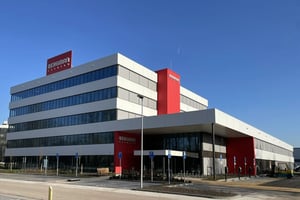Innovation can refer to technological, strategic or social change, and it can be incremental or radical and disruptive in nature. In order to have the scope to explore and experiment, you need to be able to manage your existing business efficiently. A commonly used model for structuring innovation is the Three Horizons Model for Innovation, originally launched by McKinsey in 2009. The model compares knowledge of technology (X-axis) to knowledge of the market (Y-axis).
The first horizon (H1) emerges when a company has a good working knowledge of both the technology and the market. This is where incremental innovation occurs; that is, improvements, extensions, variants and cost savings. This is also referred to as ‘process innovation’. The second horizon (H2) is created when a company starts using certain technologies for the first time, or when the company enters new markets. This is referred to as ‘business-model innovation’. The third horizon (H3) hinges on new technology which is new (or relatively new) to the entire world, often involving brand-new markets and disruptive, all-new business models.
H1 activities are marked by a high level of security and a low level of risk, and are delivered within a relatively short period of time. H3 activities, conversely, are highly uncertain, entail a high level of risk and take a fair amount of time to take shape. H2 is wedged right in the middle. Those who only focus on H1 will inevitably need to catch up to a new reality (H2) and those who fixate on a distant future (H3) are at risk of neglecting their current profit base (H1).
According to McKinsey, organisations must therefore focus on all three horizons simultaneously, but not in equal measure. Although this tends to vary depending on the organisation, the consultancy company recommends distributing the development/innovation/project budget among the three horizons in a ratio of 70%-20%-10%. This way, projects compete for resources (including financial and human resources, equipment and materials, etc.) within their own horizon, and you avoid a situation where an H1 project competes with an H3 project (as a result of which the latter is far less likely to materialise). The required mindset also varies for each horizon. Whereas H1 calls mainly for analytical skills, H2 and H3 need people with inquisitive attitudes and creative minds, which involves a different set of abilities, skills and backgrounds.
Different types of innovation
1. Technological innovation
- Product innovation: Senseo (reinvented the coffeemaker).
- Process innovation: 3D printers (have replaced processes such as milling and injection moulding).
2. Incremental innovation
- Gradual improvement: Volkswagen Golf (each generation is more advanced).
3. Radical innovation
- Any brand-new concept, ranging from the Wright Flyer to Uber.
- An all-new market strategy: PCs manufactured by Dell, the first hardware company to sell directly to consumers rather than through a distribution or reseller channel.
4. Social innovation
- Changing management styles and organisational styles, changing the way you work and collaborate: the cell philosophy conceived by Eckart Wintzen (which broke up its IT service provider BSO into several wholly independent entities).
Also read ‘Innovation means dealing with uncertainty’













